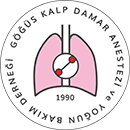

Comparison of the Efficacy between Thoracic Epidural Analgesia and Paravertebral Block in Patients Undergoing Pneumonectomy: A Retrospective Cohort Study
Özal Adıyeke, Onur Sarban, Ergün Mendeş, Taner Abdullah, Funda Gümüş ÖzcanDepartment of Anaesthesiology and Reanimation, University of Health Sciences, Başakşehir Çam and Sakura City Hospital, İstanbul, TürkiyeObjectives: This study aimed to compare the efficacy of epidural catheter and paravertebral block methods for the management of postoperative pain in patients undergoing thoracotomy and pneumonectomy and to develop clinical routines for optimal pain control.
Methods: Hemodynamic data, arterial blood gas values, VAS scores (at ICU admission and postoperative 8, 16, and 24 h), total amount of rescue analgesics for 24 h, and mortality rates of patients undergoing pneumonectomy treated with preoperative thoracic epidural analgesia (TEA) and paravertebral block were compared.
Results: Patients pain scores upon admission to the ICU and 8, 16, and 24 h postoperatively and the total amount of rescue analgesia administered during the study period were compared. VAS scores 8 and 16 h postoperatively were statistically similar between the groups. Additionally, postoperative ICU admission and 24-h VAS follow-up were significantly lower in the TEA group (p<0.05). The mean total dose (mg) of additional morphine at 24 h in PVB group was found to be statistically significantly higher than that in the TEA group (p=0.0001).
Conclusion: The data of 2,422 operations were analyzed, and 34 patients were included in this study. No statistically significant difference was observed between the groups in terms of mortality. In this study, we observed that postthoracotomy pain can be managed by paravertebral block with preoperative bolus bupivacaine. This study confirmed that paravertebral block is an effective method for achieving analgesia during pneumectomy, as recommended by the PROSPECT guidelines.
Keywords: Paravertebral block, pneumonectomy, thoracic epidural analgesia, thoracotomy
Manuscript Language: English
(646 downloaded)

















